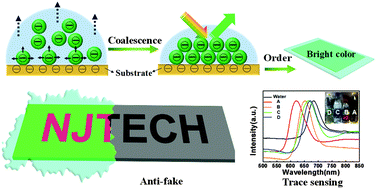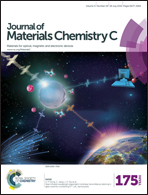Ultrasensitive responsive photonic crystal films derived from the assembly between similarly charged colloids and substrates towards trace electrolyte sensing†
Abstract
An effective method for preparing two dimensional responsive photonic crystals (RPCs) is presented in this work. Specifically, the negatively-charged latex colloids crystallize out quickly from the highly concentrated colloid dispersions as they come into contact with the similarly charged hydrophilic substrate, and two dimensional close-packed RPC assemblies with bright structural colors are then attained on the substrate surface. Combining with the poly(acrylamide-co-acrylic acid) hydrogels, an ultrathin RPC sensor along with an excellent appearance and optical evenness is finally obtained. When applied to trace electrolyte sensing, it shows highly precise and quick response characteristics. These features may make the RPCs an ideal candidate of a chemical classifier for naked-eye water quality analysis. Besides, by using a stepwise polymerization method, the resulting RPC film can be further used to convey barcode messages. The encoding messages vanish at the dried state but emerge when the film surface is smeared with water, implying potential applications in anti-forgery areas.


 Please wait while we load your content...
Please wait while we load your content...